Orange Peel Biochar–CdS Composites for Photocatalytic Hydrogen Production
Abstract
1. Introduction
2. Results and Discussion
2.1. Synthesis and Characterizations
2.2. Hydrogen Production Testing of Materials
2.3. Cyclic Stability Testing of Materials for Photocatalytic Hydrogen Production
2.4. Reaction Mechanism of Photocatalytic Decomposition of Water for Hydrogen Production
3. Experimental
3.1. Preparation of Biochar Material from Orange Peels
3.2. Preparation of CdS Blank Control Material
3.3. Preparation of CdS-C Composites
3.4. Characterizations
3.5. Photocatalytic Hydrogen Evolution
4. Conclusions
Supplementary Materials
Author Contributions
Funding
Data Availability Statement
Acknowledgments
Conflicts of Interest
References
- Yamauchi, M.; Saito, H.; Sugimoto, T.; Mori, S.; Saito, S. Sustainable organic synthesis promoted on titanium dioxide using coordinated water and renewable energies/resources. Coord. Chem. Rev. 2022, 472, 214773–214802. [Google Scholar] [CrossRef]
- Liao, G.; Gong, Y.; Zhang, L.; Gao, H.; Yang, G.; Fang, B. Semiconductor polymeric graphitic carbon nitride photocatalysts: The “holy grail” for the photocatalytic hydrogen evolution reaction under visible light. Energy Environ. Sci. 2019, 12, 2080–2147. [Google Scholar] [CrossRef]
- Zhao, Z.; Ge, G.; Zhang, D.; Cheng, B.; Yu, J. Heteroatom-Doped Carbonaceous Photocatalysts for Solar Fuel Production and Environmental Remediation. ChemCatChem 2018, 10, 62–123. [Google Scholar] [CrossRef]
- Kuang, P.; Sayed, M.; Fan, J.; Cheng, B.; Yu, J. 3D Graphene-Based H2-Production Photocatalyst and Electrocatalyst. Adv. Energy Mater. 2020, 10, 1–53. [Google Scholar] [CrossRef]
- Tang, S.; Xia, Y.; Fan, J.; Cheng, B.; Yu, J.; Ho, W. Enhanced photocatalytic H2 production performance of CdS hollow spheres using C and Pt as bi-cocatalysts. J. Catal. 2021, 42, 743–752. [Google Scholar] [CrossRef]
- Zhang, Y.; Su, C.; Chen, J.; Huang, W.; Lou, R. Recent progress of transition metal-based biomass-derived carbon composites for supercapacitor. J. Rare Met. 2023, 42, 769–796. [Google Scholar] [CrossRef]
- Jiang, J.; Zhang, Q.; Zhan, X.; Chen, F. Renewable, Biomass-Derived, Honeycomblike Aerogel as a Robust Oil Absorbent with Two-Way Reusability. ACS Sustain. Chem. Eng. 2017, 5, 10307–10316. [Google Scholar] [CrossRef]
- Fang, X.; Li, W.; Chen, X.; Wu, Z.; Zhang, Z.; Zou, Y. Controlling the microstructure of biomass-derived porous carbon to assemble structural absorber for broadening bandwidth. Carbon 2022, 198, 70–79. [Google Scholar] [CrossRef]
- Yao, P.; Zhong, W.; Zhang, Z.; Yang, S.; Gong, Z.; Jia, C.; Chen, P.; Cheng, J.; Chen, Y. Surface engineering of biomass-derived carbon material for efficient water softening. Chem. Eng. Sci. 2023, 282, 119312–119319. [Google Scholar] [CrossRef]
- Chen, G.; Wang, H.; Han, L.; Yang, N.; Hu, B.; Qiu, M.; Zhong, X. Highly efficient removal of U(VI) by a novel biochar supported with FeS nanoparticles and chitosan composites. J. Mol. Liq. 2020, 15, 45–53. [Google Scholar] [CrossRef]
- Jin, C.; Sun, J.; Chen, Y.; Guo, Y.; Han, D.; Wang, R.; Zhao, C. Sawdust wastes-derived porous carbons for CO2 adsorption. Part 1. Optimization preparation via orthogonal experiment. Sep. Purif. Technol. 2021, 276, 119270–119281. [Google Scholar] [CrossRef]
- Wang, Z.; Shen, D.; Wu, C.; Gu, S. State-of-the-art on the production and application of carbon nanomaterials from biomass. Green Chem. 2018, 20, 5031–5057. [Google Scholar] [CrossRef]
- Jin, C.; Sun, J.; Bai, S.; Zhou, Z.; Sun, Y.; Guo, Y.; Wang, R.; Zhao, C. Sawdust wastes-derived porous carbons for CO2 adsorption. Part 2. Insight into the CO2 adsorption enhancement mechanism of low-doping of microalgae. J. Environ. Chem. Eng. 2022, 10, 108265–108276. [Google Scholar] [CrossRef]
- Wang, L.; Zhang, H.; Wang, Y.; Qian, C.; Dong, Q.; Deng, C.; Jiang, D.; Shu, M.; Pan, S.; Zhang, S. Unleashing ultra-fast sodium ion storage mechanisms in interface-engineered monolayer MoS2/C interoverlapped superstructure with robust charge transfer networks. J. Mater. Chem. A 2020, 8, 15002–15011. [Google Scholar] [CrossRef]
- Lu, Y.; Cai, Y.; Zhang, S.; Zhuang, L.; Hu, B.; Wang, S.; Chen, J.; Wang, X. Application of biochar-based photocatalysts for adsorption-(photo)degradation/reduction of environmental contaminants: Mechanism, challenges and perspective. Biochar 2022, 4, 45–69. [Google Scholar] [CrossRef]
- Tan, X.; Liu, Y.; Gu, Y.; Xu, Y.; Zeng, G.; Hu, X.; Liu, S.; Wang, X.; Liu, S.; Li, J. Biochar-based nano-composites for the decontamination of wastewater: A review. Bioresour. Technol. 2016, 212, 318–333. [Google Scholar] [CrossRef] [PubMed]
- Lee, J.; Park, Y.-K. Applications of modified biochar-based materials for the removal of environment pollutants: A mini review. Sustainability 2020, 12, 6112–6127. [Google Scholar] [CrossRef]
- Abhijeet, P.; Prem, P.; Chen, X.; Balasubramanian, P.; Chang, S. Activation methods increase biochar’s potential for heavy-metal adsorption and environmental remediation: A global meta-analysis. Sci. Total Environ. 2023, 865, 161252–161262. [Google Scholar]
- Talukdar, K.; Jun, B.; Yoon, Y.; Kim, Y.; Fayyaz, A.; Park, C. Novel Z-scheme Ag3PO4/Fe3O4-activated biochar photocatalyst with enhanced visible-light catalytic performance toward degradation of bisphenol A. J. Hazard. Mater. 2020, 398, 123025–123034. [Google Scholar] [CrossRef]
- Kumar, A.; Kumar, A.; Sharma, G.; Naushad, M.; Stadler, F.; Ghfar, A.; Dhiman, P.; Saini, R. Sustainable nano-hybrids of magnetic biochar supported g-C3N4/FeVO4 for solar powered degradation of noxious pollutants- Synergism of adsorption, photocatalysis & photo-ozonation. J. Clean. Prod. 2017, 165, 431–451. [Google Scholar]
- He, J.; Chen, L.; Wang, F.; Liu, Y.; Chen, P.; Au, C.; Yin, S. CdS Nanowires Decorated with Ultrathin MoS2 Nanosheets as an Efficient Photocatalyst for Hydrogen Evolution. ChemSusChem 2016, 9, 624–630. [Google Scholar] [CrossRef] [PubMed]
- Hu, Y.; Gao, X.; Yu, L.; Wang, Y.; Ning, J.; Xu, S.; Wen, X.; Lou, D. Carbon-Coated CdS Petalous Nanostructures with Enhanced Photostability and Photocatalytic Activity. Angew. Chem. 2013, 125, 5746–5749. [Google Scholar] [CrossRef]
- Kim, M.; Kim, Y.; Lim, S.; Kim, S.; In, S. Efficient visible light-induced H2 production by Au@CdS/TiO2 nanofibers: Synergistic effect of core–shell structured Au@CdS and densely packed TiO2 nanoparticles. Appl. Catal. B-Environ. 2015, 16, 423–431. [Google Scholar] [CrossRef]
- Li, X.; Dong, H.; Wang, B.; Lv, J.; Xu, G.; Wang, D.; Wu, Y. Controllable Synthesis of MoS2/h-CdS/c-CdS Nanocomposites with Enhanced Photocatalytic Hydrogen Evolution Under Visible Light Irradiation. Catal. Lett. 2018, 148, 67–70. [Google Scholar] [CrossRef]
- Wang, X.; Liu, G.; Wang, L.; Chen, Z.; Lu, G.; Cheng, H. ZnO–CdS@Cd Heterostructure for Effective Photocatalytic Hydrogen Generation. Adv. Energy Mater. 2012, 16, 81–83. [Google Scholar] [CrossRef]
- Yu, X.; Du, R.; Li, B.; Zhang, Y.; Liu, H.; Qu, J.; An, X. Biomolecule-assisted self-assembly of CdS/MoS2/graphene hollow spheres as high-efficiency photocatalysts for hydrogen evolution without noble metals. Appl. Catal. B 2016, 3, 51–55. [Google Scholar]
- Ye, A.; Fan, W.; Zhang, Q.; Deng, W.; Wang, Y. CdS–graphene and CdS–CNT nanocomposites as visible-light photocatalysts for hydrogen evolution and organic dye degradation. Catal. Sci. Technol. 2012, 2, 969–978. [Google Scholar] [CrossRef]
- Zhu, C.; Liu, C.; Fu, Y.; Gao, J.; Huang, H.; Liu, Y.; Kang, Z. Construction of CDs/CdS photocatalysts for stable and efficient hydrogen production in water and seawater. Appl. Catal. B 2019, 242, 78–85. [Google Scholar] [CrossRef]
- Schneider, J.; Bahnemann, D. Undesired Role of Sacrificial Reagents in Photocatalysis. J. Phys. Chem. Lett. 2013, 4, 3479–3483. [Google Scholar] [CrossRef]
- Kobayashi, Y.; Nishimura, T.; Yamaguchi, H.; Tamai, N. Effect of Surface Defects on Auger Recombination in Colloidal CdS Quantum Dots. J. Phys. Chem. Lett. 2011, 2, 1051–1055. [Google Scholar] [CrossRef]
- Chakraborty, S.; Mondal, P.; Makkar, M.; Moretti, L.; Cerullo, G.; Viswanatha, R. Transition Metal Doping in CdS Quantum Dots: Diffusion, Magnetism, and Ultrafast Charge Carrier Dynamics. Chem. Mater. 2023, 35, 2146–2154. [Google Scholar] [CrossRef]
- Wang, P.; Xu, S.; Wang, J.; Liu, X. Photodeposition synthesis of CdS QDs-decorated TiO2 for efficient photocatalytic degradation of metronidazole under visible light. J. Mater. Sci. Mater. Electron. 2020, 31, 19797–19808. [Google Scholar] [CrossRef]
- Feng, Y.; Li, J.; Ye, S.; Gao, S.; Cao, R. Growing COFs in situ on CdS nanorods as core–shell heterojunctions to improve the charge separation efficiency. Sustain. Energy Fuels 2022, 6, 5089–5099. [Google Scholar] [CrossRef]
- Bera, R.; Dutta, A.; Kundu, S.; Polshettiwar, V.; Patra, A. Design of a CdS/CdSe Heterostructure for Efficient H2 Generation and Photovoltaic Applications. J. Phys. Chem. C 2018, 122, 12158–12167. [Google Scholar] [CrossRef]
- Korake, P.; Achary, S.; Gupta, N. Role of aliovalent cation doping in the activity of nanocrystalline CdS for visible light driven H2 production from water. Int. J. Hydrogen Energy 2015, 40, 8695–8705. [Google Scholar] [CrossRef]
- Huang, S.; Lin, Y.; Yang, J.; Li, X.; Zhang, J.; Yu, J.; Shi, H.; Wang, W.; Yu, Y. Enhanced photocatalytic activity and stability of semiconductor by Ag doping and simultaneous deposition: The case of CdS. RSC Adv. 2013, 3, 20782–20792. [Google Scholar] [CrossRef]
- Huang, G.; Zhu, Y. Enhanced photocatalytic activity of ZnWO4 catalyst via fluorine doping. J. Phys. Chem. C 2007, 111, 11952–11958. [Google Scholar] [CrossRef]
- Reddy, D.; Park, H.; Ma, R.; Kumar, D.; Lim, M.; Kim, T. Heterostructured WS2-MoS2 ultrathin nanosheets integrated on CdS nanorods to promote charge separation and migration and improve solar-driven photocatalytic hydrogen evolution. ChemSusChem 2017, 10, 1563–1570. [Google Scholar] [CrossRef] [PubMed]
- Reddy, D.; Choi, J.; Lee, S.; Kim, Y.; Hong, S.; Kumar, D.; Kim, T. Hierarchical dandelion-flower-like cobalt-phosphide modified CdS/reduced graphene oxide-MoS2 nanocomposites as a noble-metal-free catalyst for efficient hydrogen evolution from water. Catal. Sci. Technol. 2016, 6, 6197–6206. [Google Scholar] [CrossRef]
- Yuan, Y.; Li, Z.; Wu, S.; Chen, D.; Yang, L.; Cao, D.; Tu, W.; Yu, Z.; Zou, Z. Role of two-dimensional nanointerfaces in enhancing the photocatalytic performance of 2D–2D MoS2/CdS photocatalysts for H2 production. Chem. Eng. J. 2018, 350, 335–343. [Google Scholar]
- Li, L.; Wu, J.; Liu, B.; Liu, X.; Li, C.; Gong, Y.; Huang, Y.; Pan, L. NiS sheets modified CdS/reduced graphene oxide composite for efficient visible light photocatalytic hydrogen evolution. Catal. Today 2018, 315, 110–116. [Google Scholar] [CrossRef]
- Zhang, L.; Zhang, C.; Li, J.; Sun, K.; Zhang, J.; Huang, M.; Wang, J. Hydrothermally prepared unactivated bean sprouts biochar supported CdS with significantly enhanced photocatalytic hydrogen evolution activity. Catal. Commun. 2024, 187, 106861–106869. [Google Scholar] [CrossRef]
- Kang, F.; Shi, C.; Li, W.; Eqi, M.; Liu, Z.; Zheng, X.; Huang, Z. Honeycomb like CdS/sulphur-modified biochar composites with enhanced adsorption-photocatalytic capacity for effective removal of rhodamine B. J. Environ. Chem. Eng. 2022, 10, 106942–106953. [Google Scholar] [CrossRef]
- Banerjee, R.; Pal, A.; Ghosh, D.; Ghosh, A.; Nandi, M.; Biswas, P. Improved photocurrent response, photostability and photocatalytic hydrogen generation ability of CdS nanoparticles in presence of mesoporous carbon. Mater. Res. Bull. 2021, 134, 111085–111093. [Google Scholar] [CrossRef]
- Shi, C.; An, Y.; Gao, G.; Xue, J.; Algadi, H.; Huang, Z.; Guo, Z. Insights into Selective Glucose Photoreforming for Coproduction of Hydrogen and Organic Acid over Biochar-Based Heterojunction Photocatalyst Cadmium Sulfide/Titania/Biochar. ACS Sustain. Chem. Eng. 2024, 12, 2538–2549. [Google Scholar] [CrossRef]
- Huang, H.; Wang, Y.; Jiao, W.; Cai, F.; Shen, M.; Zhou, S.; Cao, H.; Lü, J.; Cao, R. Lotus-Leaf-Derived Activated-Carbon-Supported Nano-CdS as Energy-Efficient Photocatalysts under Visible Irradiation. ACS Sustain. Chem. Eng. 2018, 6, 7871–7879. [Google Scholar] [CrossRef]
- Norouzi, O.; Kheradmand, A.; Jiang, Y.; Maria, F.; Masek, O. Superior activity of metal oxide biochar composite in hydrogen evolution under artificial solar irradiation: A promising alternative to conventional metal-based photocatalysts. Int. J. Hydrogen Energy 2019, 44, 28698–29708. [Google Scholar] [CrossRef]
- Chen, D.; Wang, X.; Zhang, X.; Yang, Y.; Xu, Y.; Qian, G. Facile fabrication of mesoporous biochar/ZnFe2O4 composite with enhanced visible-light photocatalytic hydrogen evolution. Int. J. Hydrogen Energy 2019, 44, 19967–19977. [Google Scholar] [CrossRef]
- Qian, J.; Chen, Z.; Sun, H.; Chen, F.; Xu, X.; Wu, P.; Li, P.; Ge, W. Enhanced photocatalytic H2 production on three-dimensional porous CeO2/Carbon nanostructure. ACS Sustain. Chem. Eng. 2018, 8, 9691–9698. [Google Scholar] [CrossRef]
- Zhou, M.; Zhang, K.; Chen, F.; Chen, Z. Synthesis of biomimetic cerium oxide by bean sprouts bio-template and its photocatalytic performance. J. Rare Earths 2016, 34, 683–688. [Google Scholar] [CrossRef]
- Wei, X.; Ou, C.; Fang, S.; Zheng, X.; Zheng, G.; Guan, X. One-pot self-assembly of 3D CdS-graphene aerogels with superior adsorption capacity and photocatalytic activity for water purification. Powder Technol. 2019, 345, 213–222. [Google Scholar] [CrossRef]
- Huang, H.; Wang, Y.; Cai, F.; Jiao, W.; Zhang, N.; Liu, C.; Cao, H.; Lü, J. Photodegradation of Rhodamine B over biomass-derived activated carbon supported CdS nanomaterials under visible irradiation. Front. Chem. 2017, 5, 123–133. [Google Scholar] [CrossRef] [PubMed]
- Lei, Y.; Yang, C.; Hou, J.; Wang, F.; Min, S.; Ma, X.; Jin, Z.; Xu, J.; Lu, G.; Huang, K. Strongly coupled CdS/graphene quantum dots nanohybrids for highly efficient photocatalytic hydrogen evolution: Unraveling the essential roles of graphene quantum dots. Appl. Catal. B-Environ. 2017, 126, 59–69. [Google Scholar] [CrossRef]
- Zou, L.; Wang, H.; Wang, X. High Efficient Photodegradation and Photocatalytic Hydrogen Production of CdS/BiVO4 Heterostructure through Z-Scheme Process. ACS Sustain. Chem. Eng. 2016, 6, 6–10. [Google Scholar] [CrossRef]
- Liu, S.; Ma, Y.; Chi, D.; Sun, Q.; Chen, Q.; Zhang, J.; He, Z.; He, L.; Zhang, K.; Liu, B. Hollow heterostructure CoS/CdS photocatalysts with enhanced charge transfer for photocatalytic hydrogen production from seawater. Int. J. Hydrogen Energy 2022, 47, 9220–9229. [Google Scholar] [CrossRef]
- Bai, J.; Chen, W.; Shen, R.; Jiang, Z.; Zhang, P.; Liu, W.; Li, X. Regulating interfacial morphology and charge-carrier utilization of Ti3C2 modified all-sulfide CdS/ZnIn2S4 S-scheme heterojunctions for effective photocatalytic H2 evolution. J. Mater. Sci. Technol. 2022, 112, 85–95. [Google Scholar] [CrossRef]
- Bai, J.; Shen, R.; Jiang, Z.; Zhang, P.; Li, Y.; Li, X. Integration of 2D layered CdS/WO3 S-scheme heterojunctions and metallic Ti3C2 MXene-based Ohmic junctions for effective photocatalytic H2 generation. Chin. J. Catal. 2022, 43, 359–369. [Google Scholar] [CrossRef]
- Long, H.; Wang, P.; Wang, X.; Chen, F.; Yu, H. Optimizing hydrogen adsorption of NixB cocatalyst by integrating P atom for enhanced photocatalytic H2-production activity of CdS. Appl. Surf. Sci. 2022, 604, 154457. [Google Scholar] [CrossRef]
- Lu, H.; Liu, Y.; Zhang, S.; Wan, J.; Wang, X.; Deng, L.; Kan, J.; Wu, G. Clustered tubular S-scheme ZnO/CdS heterojunctions for enhanced photocatalytic hydrogen production. Mater. Sci. Eng. B 2023, 289, 116282. [Google Scholar] [CrossRef]
- He, K. ZnO/ZnS/CdS three-phase composite photocatalyst with a flower cluster structure: Research on its preparation and photocatalytic activity hydrogen production. Int. J. Hydrogen Energy 2024, 51, 30–40. [Google Scholar] [CrossRef]
- Liu, Y.; Dai, F.; Zhao, R.; Huai, X.; Han, J.; Wang, L. Aqueous synthesis of core/shell/shell CdSe/CdS/ZnS quantum dots for photocatalytic hydrogen generation. J. Mater. Sci. 2019, 54, 8571–8580. [Google Scholar] [CrossRef]
- Liu, Z.; Zhuang, Y.; Dong, L.; Mu, H.; Li, D.; Zhang, F.; Xu, H.; Xie, H. Enhancement Mechanism of Photocatalytic Hydrogen ProductionActivity of CeO2/CdS by Morphology Regulation. ACS Appl. Energy Mater. 2023, 6, 7722–7736. [Google Scholar] [CrossRef]
- Qi, Z.; Chen, J.; Li, Q.; Wang, N.; Carabineiro, S.; Lv, K. Increasing the Photocatalytic Hydrogen Generation Activity of CdS Nanorods by Introducing Interfacial and Polarization Electric Fields. Small 2023, 19, 2303318. [Google Scholar] [CrossRef]
- Liu, J.; Qiu, L.; Liu, Z.; Tang, Y.; Cheng, L.; Chen, Z.; Li, P.; Cao, B.; Chen, X.; Kita, H.; et al. Boosting the photocatalytic activity for H2 production of Bi2O2Se/CdS heterojunction. Mater. Lett. 2023, 345, 134498. [Google Scholar] [CrossRef]
- Meng, A.; Zhu, B.; Zhong, B.; Zhang, L.; Cheng, B. Direct Z-scheme TiO2/CdS hierarchical photocatalyst for enhanced photocatalytic H2 production activity. Appl. Surf. Sci. 2017, 422, 518–527. [Google Scholar] [CrossRef]
- Kalia, R.; Pirzada, B.; Kunchala, R.; Naidu, B. Noble metal free efficient photocatalytic hydrogengeneration by TaON/CdS semiconductor nanocomposites under natural sunlight. Int. J. Hydrogen Energy 2023, 48, 16246–16258. [Google Scholar] [CrossRef]
- Zhang, L.; Zhu, X.; Zhao, Y.; Zhang, P.; Chen, J.; Jiang, J.; Xie, T. The photogenerated charge characteristics in Ni@NiO/CdS hybrids for increased photocatalytic H2 generation. RSC Adv. 2019, 9, 39604–39610. [Google Scholar] [CrossRef]

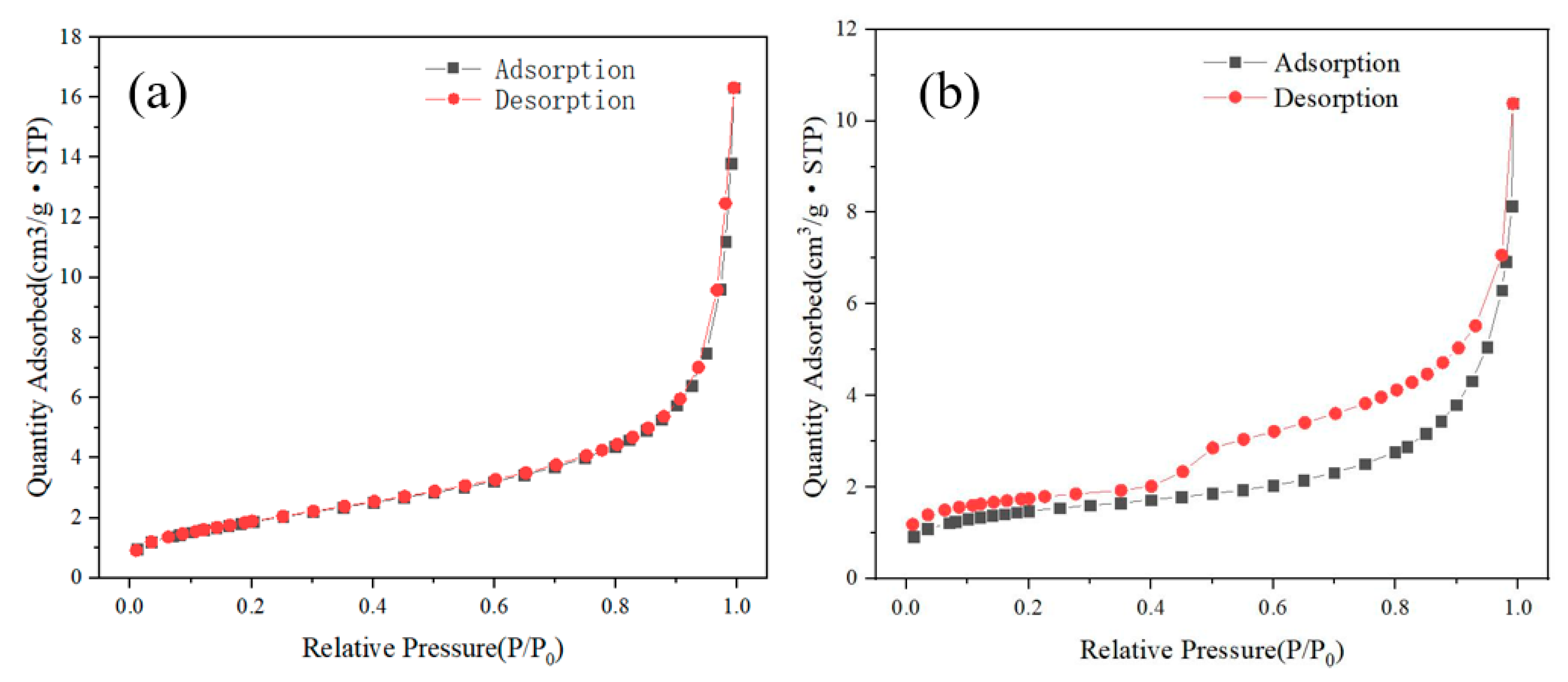

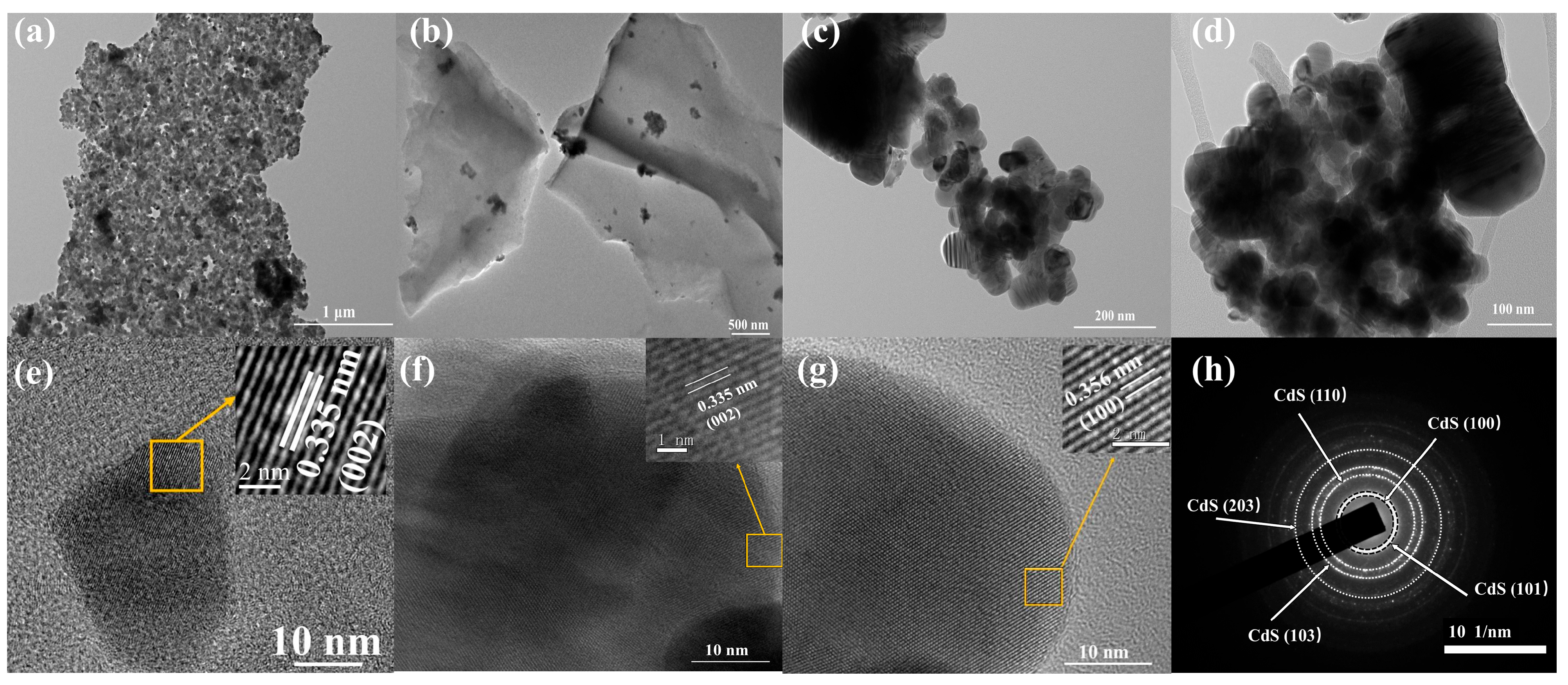
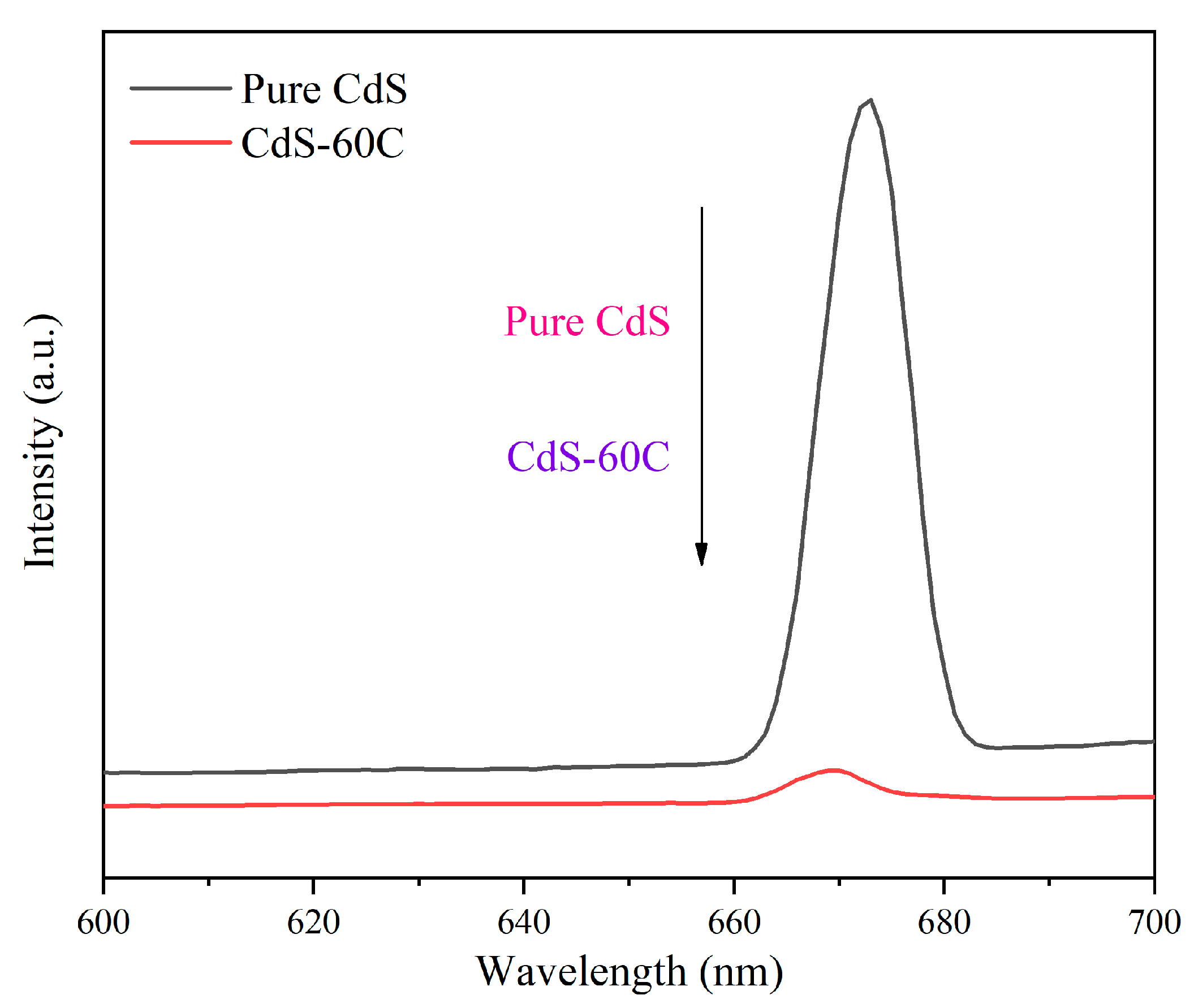
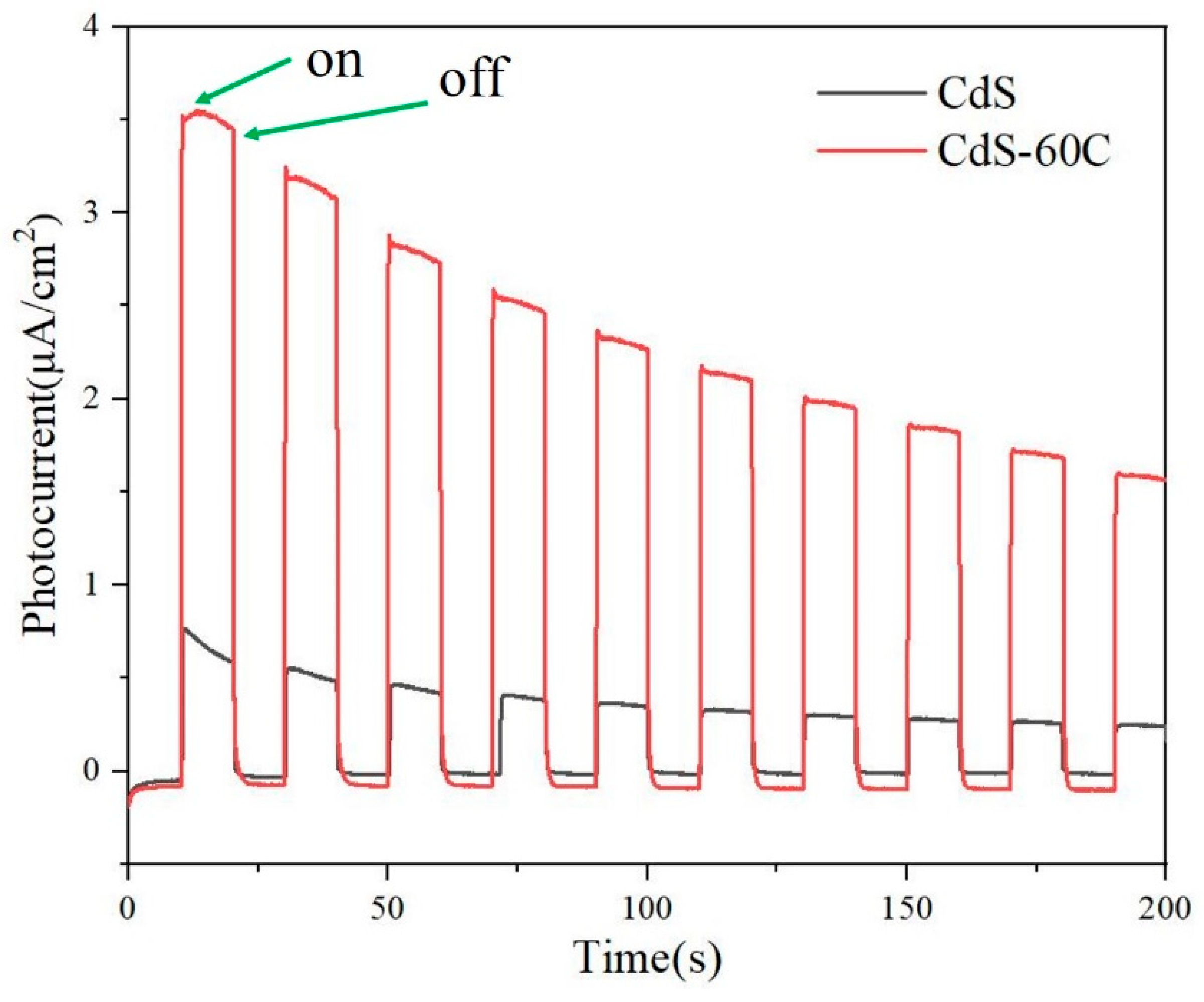
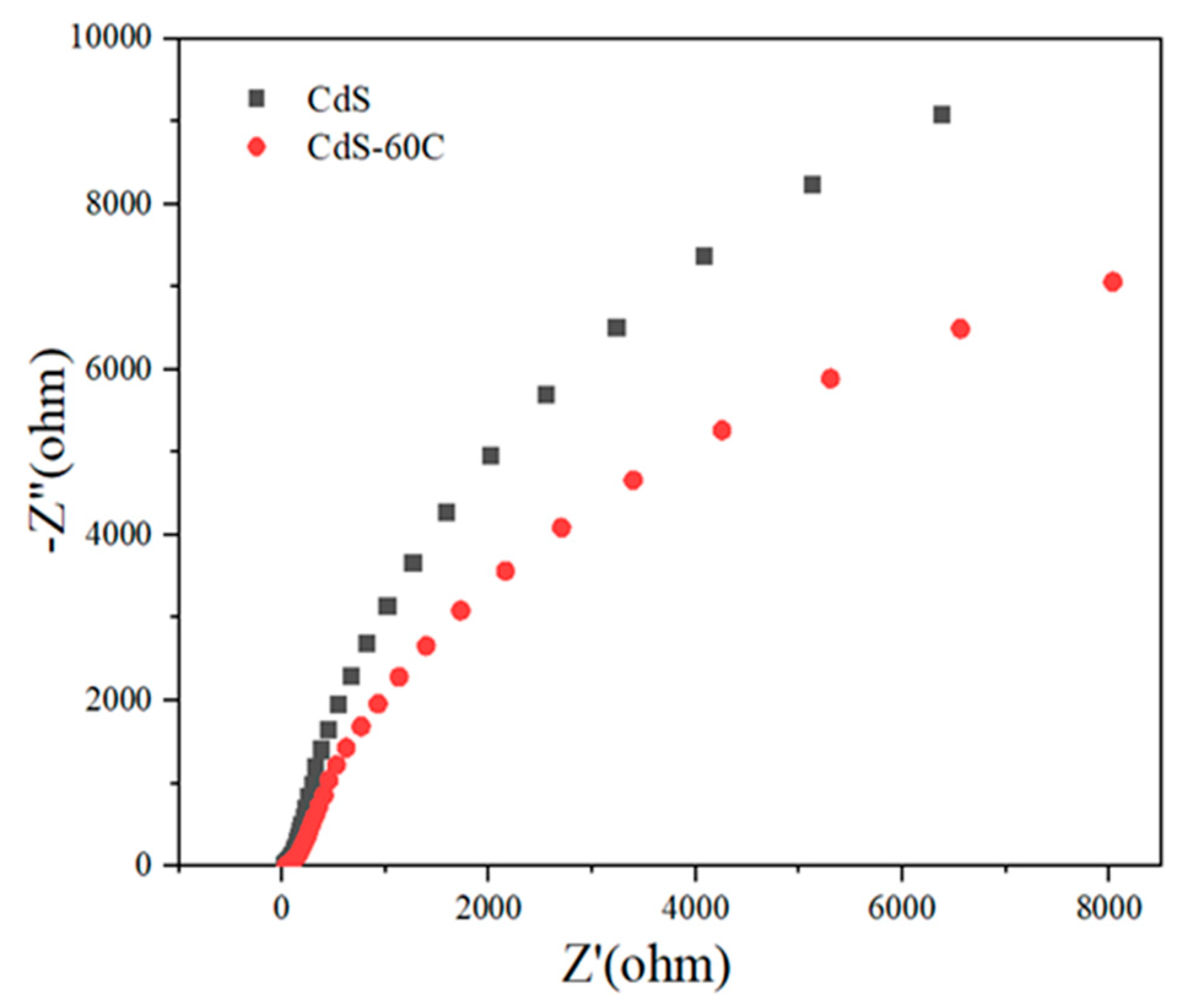
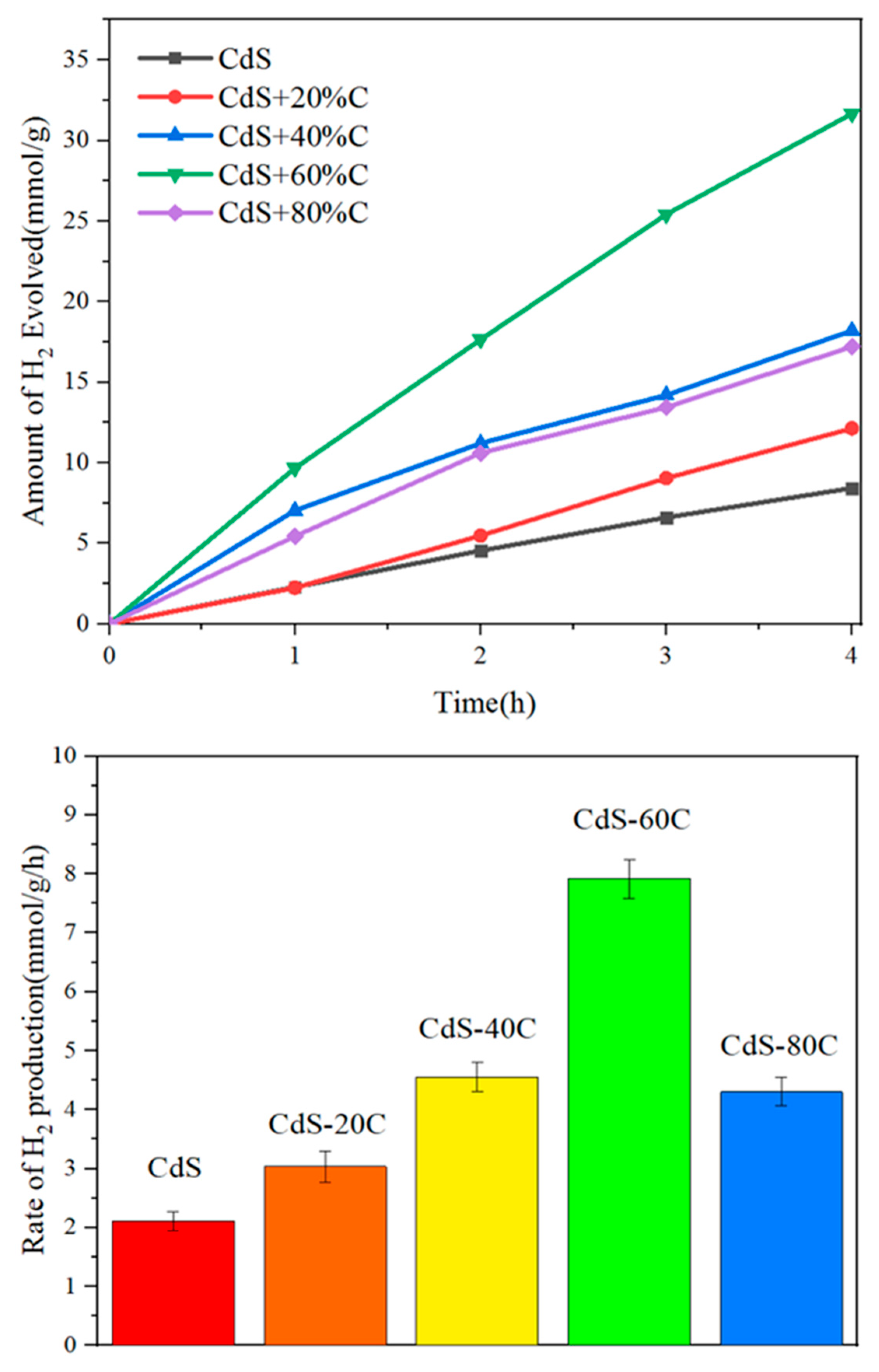
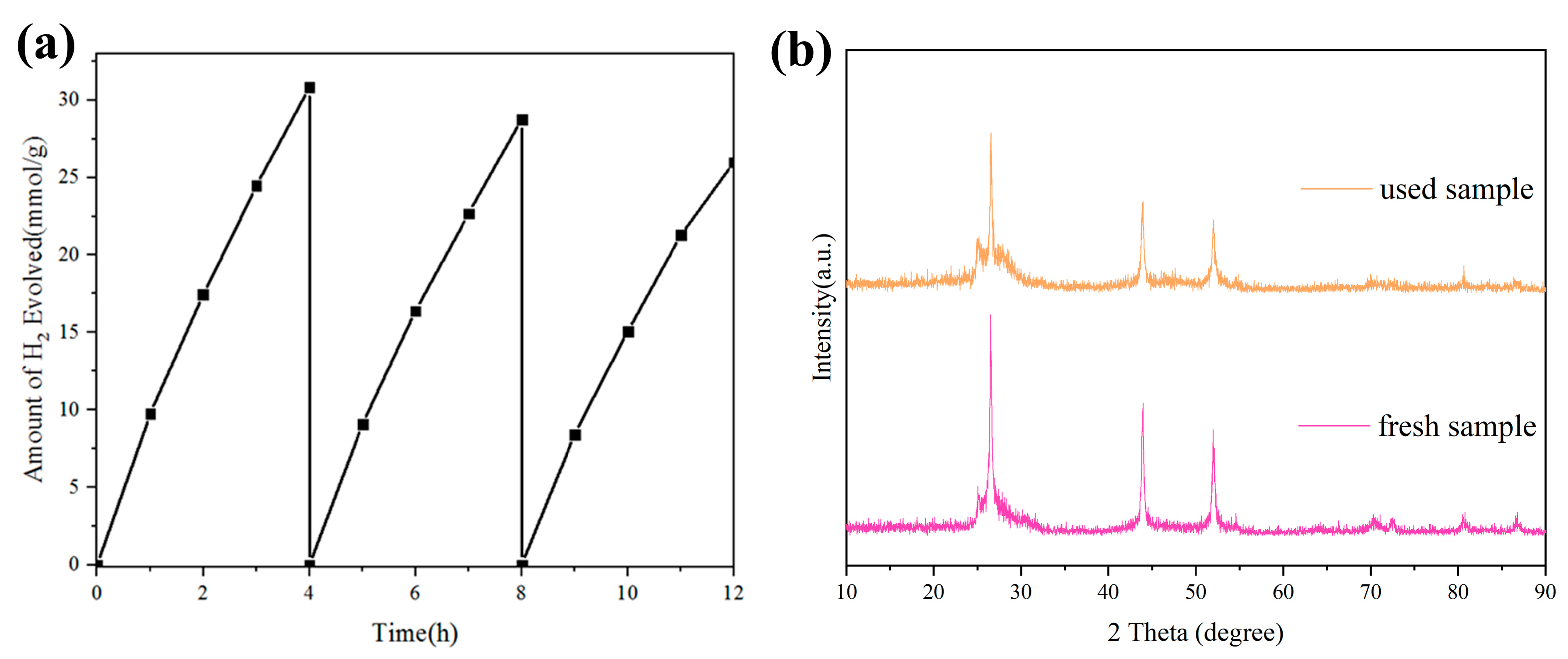


Disclaimer/Publisher’s Note: The statements, opinions and data contained in all publications are solely those of the individual author(s) and contributor(s) and not of MDPI and/or the editor(s). MDPI and/or the editor(s) disclaim responsibility for any injury to people or property resulting from any ideas, methods, instructions or products referred to in the content. |
© 2024 by the authors. Licensee MDPI, Basel, Switzerland. This article is an open access article distributed under the terms and conditions of the Creative Commons Attribution (CC BY) license (https://creativecommons.org/licenses/by/4.0/).
Share and Cite
Li, X.; Zang, Y.; Zhang, J.; Zhang, L.; Zhang, J.; Huang, M.; Wang, J. Orange Peel Biochar–CdS Composites for Photocatalytic Hydrogen Production. Inorganics 2024, 12, 156. https://doi.org/10.3390/inorganics12060156
Li X, Zang Y, Zhang J, Zhang L, Zhang J, Huang M, Wang J. Orange Peel Biochar–CdS Composites for Photocatalytic Hydrogen Production. Inorganics. 2024; 12(6):156. https://doi.org/10.3390/inorganics12060156
Chicago/Turabian StyleLi, Xiang, Yuxin Zang, Jindi Zhang, Lili Zhang, Jing Zhang, Mengyang Huang, and Jiaqiang Wang. 2024. "Orange Peel Biochar–CdS Composites for Photocatalytic Hydrogen Production" Inorganics 12, no. 6: 156. https://doi.org/10.3390/inorganics12060156
APA StyleLi, X., Zang, Y., Zhang, J., Zhang, L., Zhang, J., Huang, M., & Wang, J. (2024). Orange Peel Biochar–CdS Composites for Photocatalytic Hydrogen Production. Inorganics, 12(6), 156. https://doi.org/10.3390/inorganics12060156






